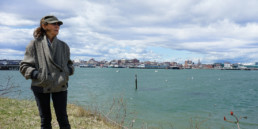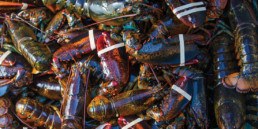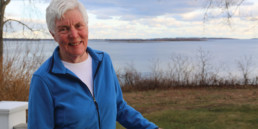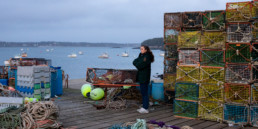Making It Here: The Island Hotelier
Phil Crossman’s Tidewater Motel represents the important tourism sector.
By PHIL CROSSMAN
Photos by WILLIAM TREVASKIS
One day this past summer one of my guests, visiting with his wife and enjoying a waterfront berth here at the Tidewater Motel on Vinalhaven, answered my customary query by responding that this had been the best day of his life and thanked me profusely for providing it.
Imagine! He’d lived 60 or so years in some other place or maybe places all over the world, and I’d provided him with the best day of his life! They were first-time visitors to the island and, for a moment, I wondered at how dull those 60 years spent elsewhere must have been for this day of modest activity to have provided him with such a delightfully quantifiable experience.
But upon reflection, I realized that my initial assessment was the product of having grown complacent about my own good fortune. He had been kayaking that morning among the seals in the Basin, a pristine and largely protected 350-acre inland salt sea on the island’s southwestern side. After enjoying the world’s most perfect lobster roll at Greet’s Eats, he and his wife had boarded the SeaBreeze, a 42-foot lobster boat piloted by the affable lobsterman Bobby Warren—who is always eager to meet and learn about new people and share his own experiences—for a cruise of several hours around Vinalhaven and among its many outlying islands. Grateful for having been reminded of my own blessings, I sent him off to what would prove to be a memorable dinner at The Haven and a perfect end to the best day of his life.
Prior to creation of the Maine State Ferry Service in the 1960s, Vinalhaven was served by an assortment of wooden vessels, the last of which carried a couple of cars and 20 or so passengers. There were then several little lodging facilities on the island: The Bridgewater, Downeaster, and Islander inns and one or two others, and these were largely home to repeat guests who came year after year and stayed several days or a week. These were stalwart folks, accustomed to the unpredictable boat rides that often found less-seasoned travelers tucked into the crowded little passenger cabin, passing a “slop jar” around as needed.
My folks occupied a big house and, with two or three of their four boys off on their own or nearly so, my mother decided to augment my carpenter dad’s modest income by “taking in boarders.” One of her first guests was Garry Moore, host of “What’s My Line,” a popular TV series of the time.
With these few exceptions, tourism was otherwise limited to the population of seasonal residents who had summer homes either in the village or tucked away farther up the island in great rambling “cottages” on the Fox Island Thoroughfare. These rusticators started arriving just after Memorial Day and settled in for the summer. They lived in another world and they remained somewhat in that other place, even while here for the summer.
Many of us, ignorant of and, I dare say, a little intimidated by that enlightened and cosmopolitan population and the world they knew, masked that insecurity in contempt. They were “summer jerks,” a term that allowed us the luxury of reversing the equation. In fact, of course, that annual influx was a “value-added” component of the town’s economy, without which it simply wouldn’t have survived as it did.
After the Maine State Ferry Service was born, allowing on each of several trips a day 10 or 12 cars and dozens more passengers, tourism took on a new life. Today, those boats carry upwards of two dozen cars, hundreds of passengers, and make six round trips a day.
“Many of us, a little intimidated by that enlightened and cosmopolitan population, masked that insecurity in contempt.”
— Phil Crossman
Interestingly, this development that spelled a big jump in the numbers of summer visitors also marked the beginning of the end of what had been a bustling retail environment. The larger and more comfortable ferry made for a more appealing ride to the islands for visitors. At the same time, it made for quick, easy, novel, and exciting shopping trips to the mainland for islanders who had, until then, contentedly done most, if not all, their shopping right here on Main Street.
Vinalhaven has been a fishing community for the better part of the last hundred years and the fished product has been pretty exclusively lobsters for the last 50 of those. The town’s gross income today is about equally split between lobstering and tourism or the businesses indirectly associated with or dependent upon them.
Still, among a minority of our own, there remains a certain disdain for seasonal visitors, for those of us engaged in providing services for those people and, for that matter, nearly anyone not engaged in lobstering. They are a macho-minority but not an invisible one.
Most of us, lobstermen and otherwise, enjoy and anticipate the annual migration and look forward to the return of old and new friends among the summer population. The few who don’t welcome those returning make their disapproval known in ways that are sometimes subtle, sometimes not. To these few, we who do not spend our days afloat are less deserving.
On the other hand, their numbers are diminishing and their disdain becoming less visible. Most of us have long since recognized the value and legitimacy of tourism and the enormous contributions some among our seasonal population have made to our quality of life across a broad spectrum. Once in a great while, someone “from away” shows up who is deserving of our scorn, and when that happens we make the most of the opportunity given us. On the other hand, the offenders have sometimes expressed their admiration for an inventive and well-executed retribution.
Today’s tourists are universally interested, foremost, in knowing where they can be fed and, between our island and North Haven, to which we can usually arrange evening transportation, we have a few choices. Nearly as many, though, are looking for things to do and most are more than content with the kayaking, birding, hiking, and boat rides or the occasional concert or speaker event. It’s those simple things, the natural beauty of the island and the vicarious appeal of sitting on a waterfront deck and watching the lobster fishing fleet go about its business that most find fulfilling. Those who don’t, who are looking for a little more excitement or for serious shopping or who find island accommodations “quaint” or “dated” are quick to move on and the numbers they leave behind are more than sufficient.
The season is pretty much from Memorial Day to Labor Day and while a certain population, far fewer in numbers, retired or with no kids in school, visit in September, there are no steps being taken to extend the season nor are there very many options. The island forest is largely coniferous so fall color is not what can be found in deciduous environments elsewhere in Maine. Besides, while we do generally enjoy the mass arrival after Memorial Day, we also like having the place handed back to us in the fall.






